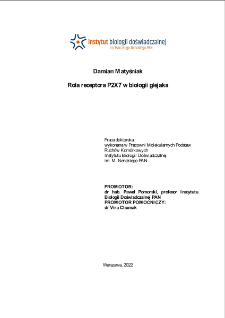
Obiekt
Tytuł: Rola receptora P2X7 w biologii glejaka : praca doktorska
Twórca instytucjonalny:
Instytut Biologii Doświadczalnej im. Marcelego Nenckiego PAN
Współtwórca:
Pomorski, Paweł (1964- ) : Supervisor ; Chumak, Vira : Assistant supervisor
Wydawca:
Instytut Biologii Doświadczalnej im. M. Nenckiego PAN
Miejsce wydania:
Opis:
168 pages : illustrations ; 30 cm ; Bibliography ; Summary in English
Instytucja nadająca tytuł:
Instytut Biologii Doświadczalnej im. Marcelego Nenckiego PAN
Typ obiektu:
Abstrakt:
P2X7 is an ionotropic nucleotide receptor that acts as a cation permeable channel upon ATP stimulation. This receptor can also form a large transmembrane pore or transmit an ATPdependent signal without creating a channel at all. P2X7 receptors control many physiological and pathological cellular processes, and their increased expression is often associated with tumor progression. Since nucleotides are important signaling molecules in the central nervous system, P2X7 also plays an important but ambiguous role in glioblastoma biology. Therefore, our research aimed to investigate the expression and function of the P2X7 receptor in three human glioblastoma cell lines (U-138, U-251, LN-229) and in one rat glioma cell line (C6). Although the receptor mRNA and protein were detected in all the studied cells, we found profound differences in their level. In U-138 human cell line, the receptor seemed to be inactive, while in U-251 human and C6 rat cell line its activation resulted in calcium influx and large pore formation. The viability of studied cells upon the administration of specific P2X7 agonist – BzATP – was not affected for U-138 and U-251, whereas for C6 cells a stimulatory effect was observed. This process is accompanied by an increase of prosurvival proteins expression (CD133, HSPA1, HSPA5) as well as an increase in phosphorylation of kinases influencing the progress of the cell cycle (Akt and p38 MAPK). It was also shown that P2X7 activation promoted cell adhesion, mitochondria depolarization, and overproduction of reactive oxygen species in C6 cells in vitro. The effect of the P2X7 receptor on the growth of C6 glioma tumors in vivo was also investigated. These results are in the line with the majority of the data obtained in vitro. The administration of BBG, a P2X7 inhibitor, effectively inhibited growth of the tumor mass and tumor development, reduced the amount of ATP with a simultaneous decrease of cancerassociated pro-survival protein expression. A decreased level of negative prognostic cancer markers (CD133, HSPA1, HSPA5, Akt, p38 MAPK, NOS-2) and proteins related to the epithelial-mesenchymal transition (N-cadherin, vimentin, β-catenin) were noted. It has also been shown that the P2X7 receptor may be involved in shaping the glioblastoma tumor microenvironment by modulating the immune response and regulating the level of inflammatory markers. These data bring some new insight into P2X7 influence on the biology of glioma. For the first time, the results showing the receptor-promoting effect on the proliferation of glioma cells in vitro were shown in correlation with the growth of neoplastic tumors in vivo. Moreover, the cell signaling pathways were investigated to elucidate the molecular mechanisms activated by P2X7 receptor in glioblastoma cells as well as the receptor engagement in shaping of glioma tumor microenvironment through modulation of inflammation marker profile.
Szczegółowy typ zasobu:
Identyfikator zasobu:
Źródło:
Język:
Język streszczenia:
Digitalizacja:
Nencki Institute of Experimental Biology of the Polish Academy of Sciences
Lokalizacja oryginału:
Library of the Nencki Institute of Experimental Biology PAS
Dostęp:
Kolekcje, do których przypisany jest obiekt:
- Repozytorium Cyfrowe Instytutów Naukowych > Kolekcje Partnerów > Instytut Biologii Doświadczalnej PAN
- Repozytorium Cyfrowe Instytutów Naukowych > Kolekcje Partnerów > Instytut Biologii Doświadczalnej PAN > Prace dyplomowe
- Repozytorium Cyfrowe Instytutów Naukowych > Kolekcje Partnerów > Instytut Biologii Doświadczalnej PAN > Prace dyplomowe > Prace doktorskie
- Repozytorium Cyfrowe Instytutów Naukowych > Piśmiennictwo > Prace dyplomowe
Data ostatniej modyfikacji:
21 gru 2023
Data dodania obiektu:
18 lip 2022
Liczba pobrań / odtworzeń:
145
Wszystkie dostępne wersje tego obiektu:
https://rcin.org.pl./publication/272414
Wyświetl opis w formacie RDF:
Wyświetl opis w formacie RDFa:
Wyświetl opis w formacie OAI-PMH:
| Nazwa wydania | Data |
|---|---|
| Matyśniak, Damian, 2022, Rola receptora P2X7 w biologii glejaka : praca doktorska | 21 gru 2023 |

 INSTYTUT ARCHEOLOGII I ETNOLOGII POLSKIEJ AKADEMII NAUK
INSTYTUT ARCHEOLOGII I ETNOLOGII POLSKIEJ AKADEMII NAUK
 INSTYTUT BADAŃ LITERACKICH POLSKIEJ AKADEMII NAUK
INSTYTUT BADAŃ LITERACKICH POLSKIEJ AKADEMII NAUK
 INSTYTUT BADAWCZY LEŚNICTWA
INSTYTUT BADAWCZY LEŚNICTWA
 INSTYTUT BIOLOGII DOŚWIADCZALNEJ IM. MARCELEGO NENCKIEGO POLSKIEJ AKADEMII NAUK
INSTYTUT BIOLOGII DOŚWIADCZALNEJ IM. MARCELEGO NENCKIEGO POLSKIEJ AKADEMII NAUK
 INSTYTUT BIOLOGII SSAKÓW POLSKIEJ AKADEMII NAUK
INSTYTUT BIOLOGII SSAKÓW POLSKIEJ AKADEMII NAUK
 INSTYTUT CHEMII FIZYCZNEJ PAN
INSTYTUT CHEMII FIZYCZNEJ PAN
 INSTYTUT CHEMII ORGANICZNEJ PAN
INSTYTUT CHEMII ORGANICZNEJ PAN
 INSTYTUT FILOZOFII I SOCJOLOGII PAN
INSTYTUT FILOZOFII I SOCJOLOGII PAN
 INSTYTUT GEOGRAFII I PRZESTRZENNEGO ZAGOSPODAROWANIA PAN
INSTYTUT GEOGRAFII I PRZESTRZENNEGO ZAGOSPODAROWANIA PAN
 INSTYTUT HISTORII im. TADEUSZA MANTEUFFLA POLSKIEJ AKADEMII NAUK
INSTYTUT HISTORII im. TADEUSZA MANTEUFFLA POLSKIEJ AKADEMII NAUK
 INSTYTUT JĘZYKA POLSKIEGO POLSKIEJ AKADEMII NAUK
INSTYTUT JĘZYKA POLSKIEGO POLSKIEJ AKADEMII NAUK
 INSTYTUT MATEMATYCZNY PAN
INSTYTUT MATEMATYCZNY PAN
 INSTYTUT MEDYCYNY DOŚWIADCZALNEJ I KLINICZNEJ IM.MIROSŁAWA MOSSAKOWSKIEGO POLSKIEJ AKADEMII NAUK
INSTYTUT MEDYCYNY DOŚWIADCZALNEJ I KLINICZNEJ IM.MIROSŁAWA MOSSAKOWSKIEGO POLSKIEJ AKADEMII NAUK
 INSTYTUT PODSTAWOWYCH PROBLEMÓW TECHNIKI PAN
INSTYTUT PODSTAWOWYCH PROBLEMÓW TECHNIKI PAN
 INSTYTUT SLAWISTYKI PAN
INSTYTUT SLAWISTYKI PAN
 SIEĆ BADAWCZA ŁUKASIEWICZ - INSTYTUT TECHNOLOGII MATERIAŁÓW ELEKTRONICZNYCH
SIEĆ BADAWCZA ŁUKASIEWICZ - INSTYTUT TECHNOLOGII MATERIAŁÓW ELEKTRONICZNYCH
 MUZEUM I INSTYTUT ZOOLOGII POLSKIEJ AKADEMII NAUK
MUZEUM I INSTYTUT ZOOLOGII POLSKIEJ AKADEMII NAUK
 INSTYTUT BADAŃ SYSTEMOWYCH PAN
INSTYTUT BADAŃ SYSTEMOWYCH PAN
 INSTYTUT BOTANIKI IM. WŁADYSŁAWA SZAFERA POLSKIEJ AKADEMII NAUK
INSTYTUT BOTANIKI IM. WŁADYSŁAWA SZAFERA POLSKIEJ AKADEMII NAUK


































